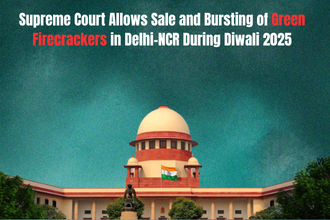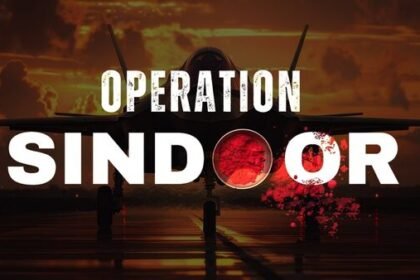New Delhi, October 15, 2025:
In a major festive relief for citizens and manufacturers, the Supreme Court of India has permitted the sale and bursting of green firecrackers in Delhi and the National Capital Region (NCR) during the upcoming Diwali festival.
The decision was delivered by a Bench comprising Chief Justice of India (CJI) BR Gavai and Justice Vinod Chandran in the long-running MC Mehta v. Union of India & Ors. case concerning environmental protection and air pollution control.
The order marks a partial relaxation of previous blanket bans on firecrackers in the region and aims to strike a balance between festive traditions and environmental safety.
The Court’s Directions: Sale and Bursting Allowed Within Strict Limits
The Bench laid out a clear and detailed framework governing the sale and use of green firecrackers, emphasizing limited duration, regulated sale, and strict enforcement.
According to the Court’s order:
“Sale of green crackers will be permitted from 18th October to 20th October. Police authorities shall constitute patrolling teams to ensure only permitted products with QR codes are sold. Violations will invite penalties and cancellation of licenses.”
The Court further allowed the bursting of firecrackers only during specific hours:
- 6 AM to 7 AM, and
- 8 PM to 10 PM
on two days — the day before Diwali and on Diwali day itself.
To prevent misuse, the Bench strictly prohibited the sale or supply of firecrackers via e-commerce platforms and directed that all vendors must be licensed and registered with the National Environmental Engineering Research Institute (NEERI).
Why the Supreme Court Relaxed the Ban
While earlier rulings had imposed a complete ban on firecrackers in Delhi, the Supreme Court acknowledged that such bans often led to illegal smuggling and black-market sales, ultimately worsening air quality instead of improving it.
The Bench observed:
“Conventional firecrackers are smuggled which cause more damage. We have to take a balanced approach… Over the last six years, green crackers have substantially reduced emissions, as confirmed by NEERI.”
The Court noted that despite periodic bans, air quality in Delhi-NCR had not improved significantly, except during the COVID-19 lockdowns, when industrial and vehicular activity was also halted. This finding prompted the Court to reconsider the proportionality and effectiveness of blanket restrictions.
Detailed Guidelines Issued by the Supreme Court
To ensure compliance and minimize environmental impact, the Court issued a series of specific directions:
- Permitted Sale Duration:
Green firecrackers listed on NEERI’s official website can be sold only from October 18 to 20, 2025. - Designated Sale Locations:
Sales must occur only at approved locations identified by each District Collector, with public notice and transparency. - Police Patrolling:
Special vigil teams, including officers from the State Pollution Control Boards, will monitor all sale points and seize prohibited stock. - QR Code Verification:
Every approved green firecracker must display a QR code confirming its registration with NEERI. Patrolling officers are authorized to take random samples for testing. - Penalties for Violation:
Manufacturers or vendors selling non-registered firecrackers will face license cancellation and legal action. - Limited Usage Window:
The use of firecrackers is restricted to two hours in the morning and evening on the two designated festival days. - Regional Restrictions:
No firecrackers from outside the NCR region may be brought in for sale or use. - Licensed Vendors Only:
Sales are limited to vendors officially registered with NEERI to prevent counterfeit or substandard products.
Balancing Festivity and Environmental Responsibility
The decision reflects a nuanced shift in the Supreme Court’s approach — from absolute bans to controlled regulation. The Bench emphasized the need for a scientifically informed balance between celebrating cultural traditions and safeguarding the environment.
The Court recognized the role of green crackers, which were first introduced following the 2018 judgment in Arjun Gopal v. Union of India. These eco-friendly alternatives are designed to emit 30–40% fewer pollutants and use reduced levels of heavy metals.
NEERI’s continued involvement ensures that certified green firecrackers undergo regular testing to verify emission standards.
Reactions from the Legal and Manufacturing Sectors
During the October 10 hearing, Solicitor General Tushar Mehta urged the Court to reconsider the total prohibition, pointing out that no conclusive evidence linked short-term air pollution spikes solely to firecracker use.
“There is nothing on record to show that poor air quality is because of firecrackers. We urge that limited use be permitted. After all, Diwali lasts only for a few hours of celebration,” he argued.
Senior Advocate K. Parameshwar, representing manufacturers, highlighted the economic consequences of prolonged bans on the industry, especially small-scale units in Sivakasi.
“We propose distributing only through 25 to 30 designated points. This will ensure strict monitoring and protect public health,” he said.
Similarly, Senior Advocate J. Sai Deepak noted that responsible manufacturers should not suffer for the wrongdoings of a few:
“An already regulated industry was further regulated. Identify and punish offenders, but don’t penalize everyone.”
The Environmental Context: Delhi’s Persistent Air Quality Crisis
Delhi’s air quality has consistently ranked among the worst in the world, with PM2.5 levels often reaching hazardous levels in winter months. The burning of stubble, vehicular emissions, and construction dust remain major contributors.
While firecrackers contribute to short-term pollution spikes, studies indicate that they are not the sole or primary cause of Delhi’s smog.
The Court acknowledged this data, noting that selective bans must be balanced against scientific evidence and public sentiment.
What Are Green Firecrackers?
Green firecrackers are specially designed to reduce emissions by up to 40% and use nitrogen-based oxidants instead of harmful barium compounds. Developed by NEERI, they emit less noise and lower particulate matter, making them safer alternatives to conventional fireworks.
Each certified product carries a unique QR code, allowing authorities and consumers to verify authenticity and trace the manufacturer.
The Supreme Court’s decision ensures that only such eco-labeled firecrackers will be available in Delhi-NCR markets this Diwali.
Broader Implications and Future Outlook
This ruling could become a template for environmentally balanced festival regulation across India. It recognizes the cultural importance of Diwali celebrations while ensuring compliance with environmental norms.
The Court also hinted that future permissions may extend to other festivals like Gurpurab, Christmas, and New Year’s Eve, provided that safety and environmental standards are maintained.
Legal experts view this as a progressive and pragmatic judgment, reaffirming the judiciary’s role as a mediator between environmental activism and social tradition.
Conclusion: A Responsible Celebration
By allowing green firecrackers under strict supervision, the Supreme Court has underscored its belief in shared responsibility—citizens, manufacturers, and authorities must work together to ensure that festive joy does not come at the cost of public health.
The order offers a practical roadmap: celebrate responsibly, comply with verified green norms, and protect both heritage and environment.
Also Read
Supreme Court Seeks Finance Ministry’s Views on Sahara Group Plea to Sell 88 Properties to Adani



